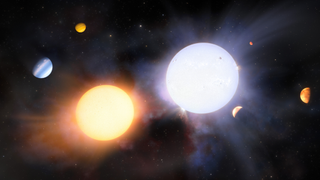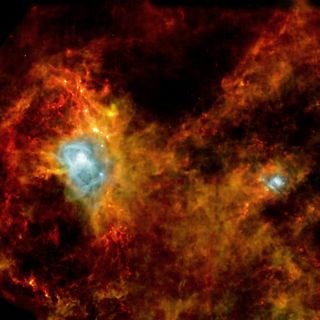Astronomers finally know why stars born from the same cloud aren't identical twins
"The universe loves diversity!"

Oddly enough, binary stars born from the same parental cloud of collapsing gas and dust aren't always identical twins. It's possible they even possess different kinds of orbiting planets. But, why would that be? Well, astronomers may finally have an answer.
Despite our familiarity with a single-star system, thanks to the sun's isolated lifestyle, an estimated 85% of stars exist with a stellar companion. These so-called binary stars are born from the same cloud of gas, meaning they presumably share the same chemical compounds — and meaning they should have almost identical chemical compositions and the same types of planetary systems.
Yet, this isn't always the case.
And, using the Gemini South telescope located in Northern Chile, a team of scientists has discovered that differences in binary stars occur as a result of variations in chemical compounds of the vast molecular cloud that births them. This information helped the crew confirm, for the first time, that differences between stars can originate from before the stars even began to form.
Related: Like the 90s, binary stars are back in style
"By showing for the first time that primordial differences really are present and responsible for differences between twin stars, we show that star and planet formation could be more complex than initially thought," Carlos Saffe, team leader and a researcher at the Institute of Astronomical, Earth and Space Sciences (ICATE-CONICET), said in a statement.
"The universe loves diversity!"
Get the Space.com Newsletter
Breaking space news, the latest updates on rocket launches, skywatching events and more!
When do twin stars begin to differ?
Prior to this study, scientists had posited three possible explanations for why stars born from the same cloud could vary. Two of these theories suggested that changes to the stars occurred long after formation.
One idea suggests random thermal movement of atoms in the binary stars could result in a process called "atomic diffusion," which would lead the atoms to settle in gradient layers, a process governed by the respective star's temperature and surface gravity. Thus, for stars in binaries with different masses and temperatures, this would explain the variation seen in chemical composition seen between the stars. Alternatively, one star in binary could eventually swallow one of its orbiting rocky planets, thus adopting some of that planet's chemical elements and introducing a variation of chemical composition.
Yet another possibility, however, is that variations in a star's composition result from primordial regions of chemical non-conformity in the giant molecular cloud that eventually births the binary stars.
Scientists have thus far found all of these explanations are possible; their studies have focused on stars in their main-sequence lifetimes. This is the period during which stars such as the sun convert hydrogen to helium in their cores, and it accounts for most of a star's lifetime.
To assess these different explanations for variable characteristics, Saffe and colleagues used the new Gemini High-Resolution Optical Spectrograph (GHOST) to study the different wavelengths of light, known collectively as "spectra," of two giant stars in a binary system called HD 138202+CD−30 12303 located around 1,720 light-years away from Earth.
"GHOST's extremely high-quality spectra offered unprecedented resolution, allowing us to measure the stars’ stellar parameters and chemical abundances with the highest possible precision," Saffe said.

The team found the stars of HD 138202+CD−30 12303 have deep and turbulent external layers called "convective zones," which allowed them to eliminate two of the possible theories. That is because the continuous swirling of these convective zones would prevent the settling of material through atomic diffusion, and the fact these are thick external layers means the engulfment of a planet would have a major impact on a star's composition as the ingested material would rapidly be diluted.
This leaves the primordial difference theory.
"This is the first time astronomers have been able to confirm that differences between binary stars begin at the earliest stages of their formation," said Saffe.
Beyond revealing the secrets of binary star variation, the team's research also has ramifications for why these stellar bodies are sometimes seen with such different planetary systems, with different stars influencing planetary evolution around them in different ways.
"Different planetary systems could mean very different planets — rocky, Earth-like, ice giants, gas giants — that orbit their host stars at different distances and where the potential to support life might be very different," Saffe said.
Furthermore, by showing how stars with different chemistry can surely come from the same gas clouds, the results may also provoke astronomers' to revise the way they identify stellar origins based on chemical makeup.
Scientists may also need to rethink their understanding of stars that had previously been suspected of engulfing an orbiting planet, as signs of this violent process on the surfaces of stellar bodies may, in reality, just be a result of how a star was born.
The team's research was published on Monday (April 29) in the journal Astronomy & Astrophysics Letters.
Join our Space Forums to keep talking space on the latest missions, night sky and more! And if you have a news tip, correction or comment, let us know at: community@space.com.

Robert Lea is a science journalist in the U.K. whose articles have been published in Physics World, New Scientist, Astronomy Magazine, All About Space, Newsweek and ZME Science. He also writes about science communication for Elsevier and the European Journal of Physics. Rob holds a bachelor of science degree in physics and astronomy from the U.K.’s Open University. Follow him on Twitter @sciencef1rst.
